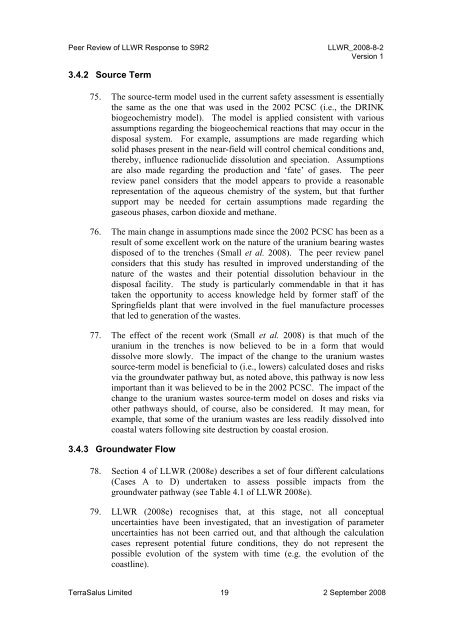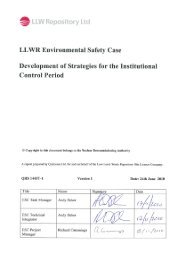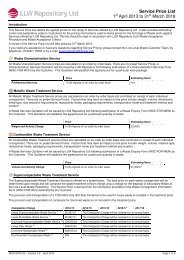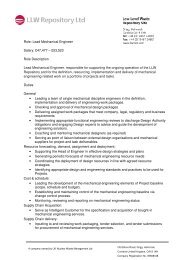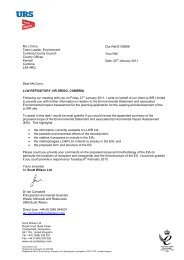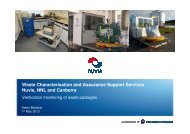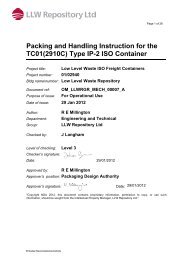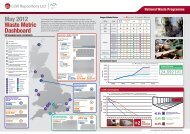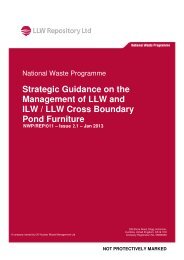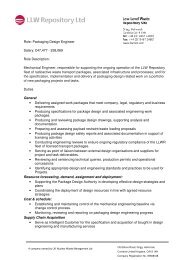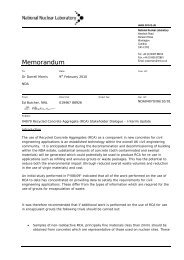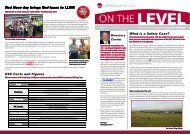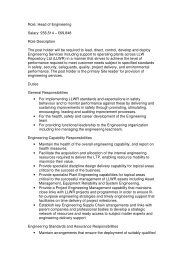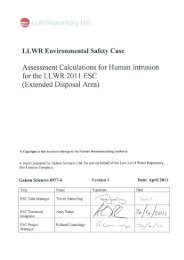Independent Peer Review of - Low Level Waste Repository Ltd
Independent Peer Review of - Low Level Waste Repository Ltd
Independent Peer Review of - Low Level Waste Repository Ltd
You also want an ePaper? Increase the reach of your titles
YUMPU automatically turns print PDFs into web optimized ePapers that Google loves.
<strong>Peer</strong> <strong>Review</strong> <strong>of</strong> LLWR Response to S9R2LLWR_2008-8-2Version 13.4.2 Source Term75. The source-term model used in the current safety assessment is essentiallythe same as the one that was used in the 2002 PCSC (i.e., the DRINKbiogeochemistry model). The model is applied consistent with variousassumptions regarding the biogeochemical reactions that may occur in thedisposal system. For example, assumptions are made regarding whichsolid phases present in the near-field will control chemical conditions and,thereby, influence radionuclide dissolution and speciation. Assumptionsare also made regarding the production and ‘fate’ <strong>of</strong> gases. The peerreview panel considers that the model appears to provide a reasonablerepresentation <strong>of</strong> the aqueous chemistry <strong>of</strong> the system, but that furthersupport may be needed for certain assumptions made regarding thegaseous phases, carbon dioxide and methane.76. The main change in assumptions made since the 2002 PCSC has been as aresult <strong>of</strong> some excellent work on the nature <strong>of</strong> the uranium bearing wastesdisposed <strong>of</strong> to the trenches (Small et al. 2008). The peer review panelconsiders that this study has resulted in improved understanding <strong>of</strong> thenature <strong>of</strong> the wastes and their potential dissolution behaviour in thedisposal facility. The study is particularly commendable in that it hastaken the opportunity to access knowledge held by former staff <strong>of</strong> theSpringfields plant that were involved in the fuel manufacture processesthat led to generation <strong>of</strong> the wastes.77. The effect <strong>of</strong> the recent work (Small et al. 2008) is that much <strong>of</strong> theuranium in the trenches is now believed to be in a form that woulddissolve more slowly. The impact <strong>of</strong> the change to the uranium wastessource-term model is beneficial to (i.e., lowers) calculated doses and risksvia the groundwater pathway but, as noted above, this pathway is now lessimportant than it was believed to be in the 2002 PCSC. The impact <strong>of</strong> thechange to the uranium wastes source-term model on doses and risks viaother pathways should, <strong>of</strong> course, also be considered. It may mean, forexample, that some <strong>of</strong> the uranium wastes are less readily dissolved intocoastal waters following site destruction by coastal erosion.3.4.3 Groundwater Flow78. Section 4 <strong>of</strong> LLWR (2008e) describes a set <strong>of</strong> four different calculations(Cases A to D) undertaken to assess possible impacts from thegroundwater pathway (see Table 4.1 <strong>of</strong> LLWR 2008e).79. LLWR (2008e) recognises that, at this stage, not all conceptualuncertainties have been investigated, that an investigation <strong>of</strong> parameteruncertainties has not been carried out, and that although the calculationcases represent potential future conditions, they do not represent thepossible evolution <strong>of</strong> the system with time (e.g. the evolution <strong>of</strong> thecoastline).TerraSalus Limited 19 2 September 2008


